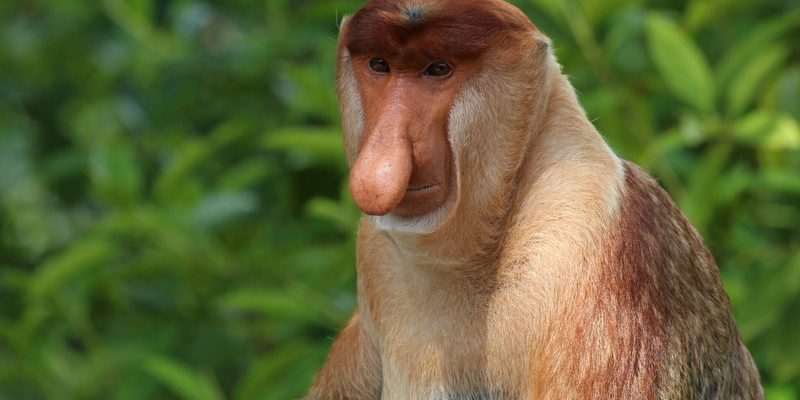![Comparing The Proboscis Monkey Vs. [Similar Species]](https://gudri.com/wp-content/uploads/2025/06/Comparing_The_Proboscis_Monkey_Vs___Similar_Species__image_0.jpg)
Imagine you’re sitting in a cozy café, sipping your favorite brew, and someone starts telling you about these two monkeys. One has a big, distinctive nose that’s hard to miss, while the other has a voice that could wake the neighbors. Sounds intriguing, right? Let’s jump into their worlds and see how they stack up against each other.
Physical Characteristics
Both proboscis and howler monkeys have unique physical traits that make them stand out in the wildlife crowd.
Proboscis Monkey Features
First off, the proboscis monkey is famous for its long, fleshy nose, which can grow up to 4 inches long! This oversized nose serves a purpose: it enhances their vocalizations, helping them communicate with each other in the dense forests of Borneo. They also have distinctively large bellies, which are perfect for digesting their leafy diet. Their fur is a mix of reddish-brown on their bodies, with lighter patches on their faces and bellies.
Howler Monkey Features
In contrast, the howler monkey is known for its stocky build and long, prehensile tail, which acts like a fifth limb as they swing through the trees. They come in a variety of colors, ranging from black to golden brown. But what sets them apart is their vocal cords. Howler monkeys are famous for their deep, booming howls that can be heard up to three miles away in the jungle. This impressive sound comes from their specially adapted throat, which acts like a resonating chamber.
Habitat and Range
Understanding where these monkeys live can offer insight into their lifestyles and behaviors.
Proboscis Monkey Habitat
Proboscis monkeys are native to the mangrove forests and riverine environments of Borneo and Sumatra in Southeast Asia. They thrive in areas with abundant water and tall trees, which provide them with not only food but also protection from predators. Their presence around water bodies is crucial, as they are excellent swimmers and often dive to escape threats.
Howler Monkey Habitat
On the other hand, howler monkeys are found throughout Central and South America, from Mexico down to Argentina. They prefer tropical forests, especially those with dense canopies. This habitat suits their lifestyle, as they tend to stay high up in the trees, munching on leaves and fruits. The variety of habitats they occupy—from rainforests to dry forests—shows their adaptability, though they are still sensitive to habitat destruction.
Diet and Feeding Habits
The way these monkeys eat and what they eat plays a crucial role in their ecosystems.
Proboscis Monkey Diet
Proboscis monkeys are primarily herbivorous, feasting on a variety of leaves, fruits, and seeds. They’re especially fond of young leaves, which are more nutritious. Their special digestive systems allow them to break down tough vegetation that many other animals can’t handle. By maintaining a diet rich in leaves, they help in seed dispersal, contributing to the health of their forest ecosystems.
Howler Monkey Diet
Howler monkeys also focus on a plant-based diet, but they lean heavily on ripe fruits and tender leaves. They are constantly on the move, munching throughout the day to find the best food sources. Their strong jaws allow them to crush tough leaves, and their diet helps them stay energetic enough to vocalize their howls. By feeding on various trees, they too play a significant role in maintaining their forest habitats.
Social Structure and Behavior
Looking into how these monkeys interact with each other reveals more about their lives.
Proboscis Monkey Social Structure
Proboscis monkeys are known for their social groups, which usually consist of one dominant male, several females, and their offspring. The males are often larger and have that impressive nose, which helps them establish dominance. They groom each other to strengthen social bonds, and their groups tend to be quite cohesive, often moving together as a unit throughout their territory.
Howler Monkey Social Structure
Howler monkeys form groups as well, but their social structures vary between species. Generally, they also have one dominant male and several females. Interestingly, their groups can be smaller than those of the proboscis monkeys, often consisting of just a few individuals. They are more vocal than their proboscis cousins, and their loud howls serve as both a territorial warning and a way to strengthen group cohesion.
Conservation Status
Both species face threats due to habitat loss, but their conservation status varies.
Proboscis Monkey Conservation
Proboscis monkeys are classified as endangered. Deforestation for agriculture and logging has dramatically reduced their habitat, making their populations vulnerable. Conservation efforts focus on protecting their natural habitats and raising awareness about the importance of biodiversity in these regions. Programs aimed at sustainable land usage are essential for their survival.
Howler Monkey Conservation
Howler monkeys, while facing similar threats, have several species with different conservation statuses. Some populations are more stable, while others are endangered. Efforts to conserve howler monkeys often include habitat preservation and restoration, along with education campaigns to reduce hunting and capture. Their adaptability to different environments helps some populations survive better than others.
So, what have we learned by comparing the proboscis monkey and the howler monkey? Each has its own unique characteristics, behaviors, and habitats that contribute to the incredible diversity of primates. While they might share some similarities, their differences paint a vivid picture of how creatures adapt to their environments.
Understanding these animals helps us appreciate the beauty of our natural world and the importance of protecting it. Whether it’s the quirky nose of the proboscis monkey or the resonant howls of the howler monkey, both serve as fascinating reminders of the richness of life on Earth. Let’s keep celebrating and preserving it—after all, every species has its role in the story of our planet.

